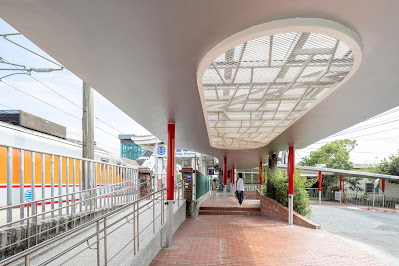龔書章、王增榮盛讚 林聖峰與曾泊銘設計之美 國立歷史博物館整建案成為建築經典
國立歷史博物館的巧妙改造:融合現代設計與傳統建築之美
在台灣的文化設施中,位於位於台北市中正區南海學園內國立歷史博物館的整建案無疑是一個備受矚目的例子。龔書章教授對於這個改建案持正面態度,認為它巧妙結合了歷史建築的保存和現代設計的創新。他強調,設計者林聖峰與曾泊銘的作品絕對值得深入討論,並期待親自前往體驗,以確保自己的觀點更加客觀、全面。改造案讓人驚艷的部分在於對歷史建築原有元素的保留與再利用。例如,主入口的大紅門經過略為位移,仍然保持原本的風貌,並在重新定位後成為展廳的一部分。左右兩側的拱門也經過精心設計,成為館內重要的無障礙坡道與販賣部入口。在改建過程中,設計師將這些舊建築的元素納入新的設計理念,使之成為整體展覽空間的一部分,巧妙地增添了建築的文化氣息。
歷史與現代的共生:空間重整與展覽策略
在整建過程中,設計團隊對博物館的空間進行了充分利用,將一至三樓的展覽空間最大化,服務設施則放在四樓,這種策略為展覽區創造了更廣闊的視覺與空間感。設計師通過使用大片落地玻璃門,為入口大廳帶來明亮開闊的氛圍,使得歷史與現代在空間中達到一種完美的共生。此外,館內的一些休憩空間如長廊,目前仍未被充分利用,雖然背靠荷花池,但由於沒有擺設家具供遊客休息,這部分稍顯不足,或許是管理方面的考量。主樓梯的翻修則保持了原有風貌,重新粉刷後的低調色調與整體建築相互呼應,設計師希望保留原始的美感,同時以現代的視角重新展現其特點。
整體而言,這次改造案呈現了歷史與現代融合的經典範例。設計師不僅保留了歷史建築的原貌,還賦予其全新的功能,使國立歷史博物館成為台灣舊建築整修中的一個成功案例。
龔書章:我不會用「粗暴」來形容這個作品
陽明交大建研所教授龔書章轉貼王增榮在臉書上對於「國立歷史博物館」改造案的發言,並且表示(出處:龔書章 facebook):王增榮:這是舊建築整修的作品中相當成功的例子!
王增榮在臉書上對於「國立歷史博物館」改造案的發言如下
國立歷史博物館 / 曾泊銘建築師 + 嶼山設計
這次整建最讓人驚艷的是,以增加無障礙坡道與販賣部之名巧妙地將左右兩側拱門變成被就地收藏的文物,而主入口的大紅門則透過略為位移的方式,也就地成為文物,而退了之後留出的空間,配合大面落地玻璃門的處理,讓入口大廳更顯寬鬆!
歷史建築在整建過程中,透過設計動作,讓舊建築元件就成成為收藏的文物是國外常使用的作法,像[tag]安藤忠雄[/tag]在東京舊國會圖書館再利用為國際兒童圖書館的設計,從主樓梯手到三樓的舊窗都是這樣處理,如果我的記憶沒錯,國立歷史博物館有可能是國內的先例!
歷史博物館的規模其實不大,這次的整理看得出來是以展覽空間為主,其他服務設施為輔的策略,把一到三樓作為最大化的,而且還有潛力串連為一體的展覽空間,餐飲放在四樓,這是非常合理的安排。其實一、二樓中央展區朝向荷花池的背後,目前都留有長廊式的休憩空間,但都沒有擺設傢具讓人停留,有點可惜,莫非又是管理的考量不成?
本以為主樓梯是設計者新注入的元素,結果翻閱李乾朗老師的書,看到他畫的剖透圖裡原位置就有樓梯,向志工請教,也確認樓梯本在這個位置,設計者只是重新翻修,從顏色的使用來看,設計者似乎也希望它變得低調。
總之,個人覺得這是舊建築整修的作品中相當成功的例子!
精彩回顧
BG台南安平跨港大橋動工,勾勒城市新視野!預計2027年底完工打通任督二脈
Tezuka Architects 日本建築師手塚貴晴、手塚由比 在倫敦巴比肯藝術中心演講談童年影響與建築實踐
「跨界合作,開創未來」金門大學建築系學生展覽揭幕:從理論到實踐的創新跳躍
金點沙龍成為亞洲設計交流重要平台,台灣、泰國、馬來西亞設計師共探設計文化與創新
台灣青年建築師的創意賽場!2024第七屆ADA新銳建築獎等你來挑戰
AI TWINS智繪双子星:顛覆台灣建築設計的革命性力量!
XRANGE Architects 十一事務所|徵才
石上純也設計家具,在輕盈與嚴肅間尋找平衡,創造無與倫比的美學家園
今年夏天,讓我們一起探索台灣建築的靈魂——國父紀念館的走讀活動,錯過將是你的遺憾!
面積多9倍!汐止消防分隊廳舍動土,楊志宏建築師事務所設計監造,晨鑫營造股份有限公司承造
公私交流攜手打造幸福城市! 台中市建設局邀建築師及結構技師公會進行座談
陳文耀接棒澎湖建設處長:高雄建築師的新挑戰與願景
香港灣仔新地標「鏡院」綻放:間外建築工作室以迷宮藝術致敬城市與童年記憶
從1999到2024:台灣地震災害後的建築耐震規範與都市重生
羅必達領航 高雄市建築師公會新篇章
島嶼構竹新銳建築展開創綠建築新浪潮:台灣竹構造的環保革命與未來展望
由傳統到現代:波哥大Universidad EAN大學新教育設施,Heatherwick Studio展現哥倫比亞手工藝之美
Bruno Mars聯名設計「The Pinky Ring」酒吧重新定義拉斯維加斯奢華夜生活
台灣建築師的美學探索:2024年第九屆台灣住宅建築獎獲獎者公布!
時光倒流看林口:30年房價大揭秘
MVRDV設計、策展「過去、現在、未來:荷蘭館的三重時空旅程」:透過台北國際書展荷蘭主題館的三個圓形空間,漫遊荷蘭與台灣交織的歷史與未來願景
16億大改造!國父紀念館2024年2月26日起閉館整修 2027年再見!
高雄小港運動中心春節後動工,為民眾打造全方位運動空間,趙建銘建築師事務所設計監造
建築與環境對話:「Kalyon Karapınar 1.350 MWp SPP」太陽能發電廠,展現土耳其在永續能源領域的領導力
一次過六科,台中青年陳顥仁躍登建築師榜單:跨界才華照亮建築與文學之路
美國華盛頓州名建築師Moritz Kundig辭世,享耆壽98歲
Richard Meier在韓國的傑作——Sorol Art Museum 美術館:融合自然與現代建築的詩篇
台南市溪東里活動中心2024年2月18日動土 顏夷伯建築師事務所設計監造
台灣師範大學設計系輝煌獲獎!美國建築大師獎見證符馨、鍾頤萱、廖季淳、趙昱優秀作品 鄧建國、林俊良、長友大輔啟發未來設計師
「地形作為建築」講座:周防貴之談建築設計與自然的和諧共生 2024年3月6日
春天的承諾:中友百貨彰化店2024年3月底開工,為彰化帶來新希望與活力
屏東「藝起趣宜居潮州」喜訊 獲法國設計獎建築設計類金獎
尋找建築與人心之間的橋樑:林彥穎的建築哲學
台灣公共建設經常被終止,何震寰提出對策促進公共利益與專業價值平衡
探索執業新天地 台灣建築師的國際之路「建築師執業規章與國際接軌」論壇 2024年3月16日
將鰻魚的流動之美融入建築中 鰻魚加工工廠「S-Lab4th」隈研吾在橋本町的環保創新
台南南區集會新據點:台南文南里活動中心動土 境謙建築師事務所設計監造
勤美達精密機械 大中華區鑄造巨擘的綠色轉身 潘冀聯合建築師事務所設計傑作
2024 TRAA台灣住宅建築獎入圍決選名單公布 打造居住藝術新高峰!
臺南的記憶重現:文化部補助老屋展 2024年1月24日至2月6日中西區公園路8號
疫情中的堅持與轉變:嘉義聖荷西商務大飯店的危老重建,開啟植物人長照新篇章
台北田徑場驚艷蛻變:2年策劃下的智慧型運動空間,運動熱潮在此重燃!台灣設計研究院揭示未來體育新里程
東京「學習、學習舍」:VUILD與Explayground計畫合作成果,將3D加工技術應用於教育空間
臺北北門新生:建城140週年慶典揭幕,楊仁江建築師主導修復計劃,凸顯文化傳承
基隆田徑場設計違約將更換監造 直域建築師事務所提送第二次變更設計仍延宕造成損失 決先由建築師公會協助推薦新事務所
新竹縣竹北市文興國小校舍動土 融合綠建築打造環保教育環境 大同聯合建築師事務所設計監造
日本最高木造大樓在東京日本橋動土 預計2026年竣工
Swarovski Optik與Marc Newson聯手 AI望遠鏡「AX Visio」帶來觀鳥革命
台中巨蛋工程簽約 預計2024年3月正式動工 2030年啟用
碳中和先行者 新北市2024年6月啟動建築碳排量申報制度
台中市社宅再邁新里程碑 豐原安康二期好宅上梁 興亞營造承造 開務聯合建築師事務所設計監造
設計改變世界 石巻工房的創意之旅「石巻工房の仕事」展在東京代官山 2024年1月5日〜 1月28日
台南首座智能全民運動中心2024年1月2日啟用 開放2周免費試營運
AK
2024年TRAA台灣住宅建築獎揭曉:和光接物環境建築設計「新竹謝宅」、大尺建築+郭旭原聯合建築師事務所「璞園貴象」分獲單棟及集合住宅首獎,無名樹設計「小大之間」獲特別獎肯定
2024年台灣住宅建築獎,台灣建築師將傳統與創新融合於每磚每瓦
2023雙北逆勢房價案例曝光 住展雜誌深度解析
台南九份子房市爆發:泰嘉開發引領區段新高潮 泰嘉一字寬成交驚見39.4萬元實登
國泰建設砸10.45億 收購北屯四期重劃區718坪透天
嘉義轉型序幕:「Ai世界城」開工,南台灣房市迎來新紀元!三大巨頭聯手造鎮,城市面貌即將改寫
單元二新篇章:打造台中豪宅新地標,頂級生活藝術聚落成形
百億黃金國有地 台中七期地上權 重啟招商
打造台中成為「盛典城市」!3大重大建設齊鳴 台中巨蛋、市政路延伸將開工
2023年底房貸餘額首破10兆元:央行公布歷史新高,房市熱度未退
2023年Q4台灣房市分析:國泰指數顯示「價穩量增」,台北季漲居冠
南二都房市魅力:台南中西區與高雄鹽埕區房價分析
台灣建築面對低溫挑戰:台中建商以新建材與工法應對
2024年7月「囤房稅2.0」上路 台北自住客面臨衝擊
中國春節返鄉置業 市場活躍度的新希望
櫻花建設2024年營運大躍進 新案爆發帶動業績飆升
台南九份子新築話題作「泰嘉一字寬」,開啟綠建築新篇章
FG
歐米茄攜手ORBIS國際慈善創佳績:超霸專業登月系列新面孔
宇舶錶2024新作亮相,瑞士精湛工藝再創高峰
2024年值得期待的18款電動車
遠方思鄉與音樂啟蒙:Michael Bublé的夏日回憶
英國政經未來趨勢 脫歐與消費衝擊
李小龍傳奇再現!SEIKO限量聯名腕錶 跨時代的時尚對話
為什麼台灣吸引不了日本觀光客?疫情結束後,台日觀光逆差放大超過5倍
10個奢華腕錶品牌背後的故事:藝術與時尚的交織
傳統建築的現代詮釋 探訪Aesop Seochon首爾旗艦店 韓國美學與香氛結合
日本鰻魚的古老傳統與現代變遷 夏季必吃「土用丑日」的鰻魚文化
Hermès H08腕錶 時尚界新星 Philippe Delhotal打造的愛馬仕鐘錶傳奇
Casio手錶的蒂芙尼風采,「Casio Tiffany」湖水藍手錶大熱
TK
褚瑞基:過去及現代的爭辯 (Querelle des Anciens et des Modernes)
古蹟專家李乾朗:不能接受史博「打開紅牆」 | 史博館整建爭議
建築師成員 修復新竹「將軍村」惹議
玻璃盒擋紅牆、龍谿園變枯山水 史博館整建挨批
龔書章、王增榮盛讚 林聖峰與曾泊銘設計之美 國立歷史博物館成為建築經典
呂欽文:新史博館只剩蒼白與荒謬
台南新地標:安平跨港大橋動土,預計三年後完工助解交通壅塞
金門大學建築系為何能培養出具備全方位技能的建築師?學生展覽讓你看見未來建築的多元可能!
台灣新銳建築才俊競技場!2024年第七屆ADA新銳建築獎邀您共襄盛舉
台灣新創AI TWINS智繪双子星:建築設計業革命性突破!
每一磚每一瓦都在訴說歷史,讓國父紀念館的走讀活動帶你深入台灣建築的心臟!
汐止消防分隊廳舍動土!預計2027年完工,將大幅增加救災效能
挑戰傳統建築界限:陳冠帆於公視《藝術很有事》分享結構與建築的一體化思維
受泰戈爾影響設計的校園:走進與自然交錯的步道,印度班丹商學院Bandhan Residential School of Business/Abin Design Studio
藥局也能是社區關懷據點!費城Angel Care Pharmacy如何透過設計關懷阿片危機患者?
融合古蹟與現代設計!Vitra在歐洲悠久建築中展開全新家具展廳:跨越歷史的品牌展示空間
澎湖縣政府揭曉新建設處長:高雄建築師陳文耀赴島嶼迎新征程
403花蓮大地震引發警鐘:台灣老舊建築安全與都市更新迫在眉睫
羅必達任理事長 高雄市建築師公會展新篇
日本平田晃久建築師拜會竹市府 邱副市長:圖書館新總館展現「台日設計」新面貌
從高雄到亞洲 曾瑞宏領軍綠色實驗室 尋找氣候建築新解方
以陶淵明為靈感作品參賽 台師大師生團隊獲美國建築大師獎
作為地形的建築:周防貴之在東京港區的深度對話 2024年3月6日
彰化中友百貨為何遲遲未開工?背後的原因將讓你重新評估地方發展
紅牆綠瓦的史博館曾經很「日本」? 改建關鍵是測繪紫禁城的他
隈研吾來台現勘「聯聚中維」 打造亞洲新地標
復古控必看! 台南低調神秘的「文資建材銀行」
台灣建築學會主辦「建築師執業規章與國際接軌」論壇 2024年3月16日在臺灣科技大學登場
【顛覆認知】您知道鰻魚加工廠也能成為藝術品嗎?隈研吾在茨城縣橋本町的創新之作
台灣住居創意新高峰!「2024第九屆traa台灣住宅建築獎」入圍決選名單公布
城市記憶的重現 臺南市政府文化局老屋展
FA
林聖峰與曾泊銘妙手回春 國立歷史博物館嶄新文化定位 引發龔書章與王增榮讚譽
重寫城鎮文化記憶:充滿色彩的新型第三空間,法國小鎮佛日聖迪耶文化和遊客中心La Boussole/Dominique Coulon & associés
中國美術學院良渚校區一期全面啟用:張永和主導創新校園設計,推動學生跨領域學習
有沒有想過加入台灣首位獲AIA國際設計獎的建築團隊?XRANGE十一事務所等你來!
老建築新生命!屏東「HKhun酒店」混合時代記憶:透天厝融合創新設計,展現城市新風貌
連結國際與解決衝突:跨國文化與和平共融場域,地中海上的三公里「多米諾環」Domino/Studio Nab
3D蕾絲編織古今:SO-IL在比利時創造「Common Thread」穿越歷史
狹窄旗杆地變身隱秘住所!日本西宮市「夙川住宅」的光影空間/堤庸策
結合天空與大地的建築哲學,印度班丹商學院Bandhan Residential School of Business/Abin Design Studio
竹構的自然節奏:林柏陽「浮林」捕捉與反映環境的瞬息萬變
懸臂結構下的休憩天堂,南非新典範宅邸Casa Beiramar/Metropole Architects
以「布板模」混凝土創造出的家園,Omer Arbel「75.9 House」結合材料實驗與自然景觀
James Turrell:「我的作品就是光。」— 探索以光為媒介的藝術邊界
灣仔海濱變身藝術迷宮:馮國安建築師「鏡院」鏡面迷幻空間重塑香港夜景
探尋知識無限可能:南非曼德拉大學的學習聖地,新科學中心New Science Centre – Nelson Mandela University (NMU)/SVA International
探索義大利FENDI皮件生產園區,工廠如何成為自然、工藝與社區的橋樑?FENDI Factory/Piuarch
串連傳統與現代的美食之旅:重現記憶裡的味道,台北南門新市場重建/九典聯合建築師事務所
沉浸於知識海洋,北京潮白河濕地「船底之家」/察社辦公室
丹麥民主新篇章「一個屬於所有人的民主舞台」哥本哈根國會廣場改造計劃
法國航太之都交通革新:BIG聯手A+Architects打造土魯斯交通新地標Marengo Multimodal Transport Hub
荒廢草地重生:雪梨哈斯頓公園內的Y型活動中心,開放設計促進無界限的社區交流
隈研吾設計新品「○○□」揭曉 與自然對話的家具之美 坂本龍一遺願成真 more trees與Pearl+聯手打造
行動自由無設限!實現永續夢想的西班牙移動式零耗能住宅MO.CA/IAAC
啟蒙未來的樂園:印度幼兒園童夢成真KLE Sanskruti Nipani/Shreyas Patil Architects
240片太陽能電池板一次到位 奧地利公司發明「Solarcontainer」移動發電站,太陽能電廠進駐你家!
探索生活與設計的無限可能:2024年第九屆台灣住宅建築獎揭曉「新竹謝宅」及「貴象」分獲單棟及集合住宅首獎, 「小大之間」獲特別獎肯定
投入大自然懷抱:輕井澤森林書店「Karuizawa Commongrounds/軽井沢コモングラウンズ」複合設施/Klein Dytham Architecture
平田晃久建築團隊訪新竹市府 邱副市長期待新竹市圖書館新總館「知識峽谷」成新地標
荷蘭住居風情融入鄉土:果園綠建築住宅Orchard House/Earthbound architecture and Namelok
從舊宅到現代辦公:巴西律師事務所總部創新轉型/BLOCO Arquitetos + Renata Dutra Arquitetura
探索內在平靜的熱帶避風港,巴西當代住居Serena House/Módulo 4 Arquitetura
山本理顯獲頒2024普利茲克建築獎,融合公私空間,重塑日常生活的建築哲學
超越停車場的設計:穆哈拉格立體停車場,Christian Kerez如何重新定義公共空間?
荷蘭森林中的隱秘鳥巢:Buitenverblijf Nest為自然愛好者打造終極休憩地/NAMO Architecture + i29 architects
遠離塵囂的心靈避隱地:巴西綠意日式料理Ikigai Cozinha Afetiva/Hiero Arc
與大地對話:土耳其潔淨能源願景,Kalyon Karapınar 1.350 MWp SPP太陽能發電廠/Bilgin Architects
深夜食堂新選擇:「ザ・銀皿」居酒屋,東京目黒區的隱藏寶藏
慈湖上的建築詩篇:清遠慈湖書院的靜謐與孤寂,在自然中尋找心靈歸宿
文化地標再進化!台北國父紀念館大變身2024年2月26日起閉館整修打造進化版場館 預計2026年第4季完工
台中舊城區走讀:探索老屋改造的無限可能
北京內城瑰寶!「小堂12號」四合院重生,IARA再現老建築歷史風華
轉型美學:從五變二的奧地利度假公寓改造House Sutter/firm Architekten
大稻埕新風貌:「台灣日和」與3+2 Design Studio聯手,展現島嶼記憶選物店
竹構與花藝的絢麗交織:2024花在彰化「繁境」系列地景裝置,亼光工作室的創意國度
新莊泰山區的都市綠洲!工業區中的生態接待中心「積木之森」/術刻建築師事務所
不只品酒與美食,還有感官旅程:在西班牙「Bodegas LAN」葡萄園中與自然共餐
新春快樂,大年初六開工大吉 台中市都發局迎接工作的第一天
MVRDV 改造百年水泥廠「GATE M 西岸夢中心」立體步行網路 從工業遺產到上海新地標的華麗蛻變
從海洋生物到建築靈感,馬爾地夫悅榕度假村Madi Hiyaa/Atelier Nomadic
樹木啟發的建築藝術,印度建築師總部大樓ATREY DESIGN STUDIO Office/ATREY & ASSOCIATES
日本福島自然共生住宅「柱群の家」:IGArchitects打造雙家庭安寧棲所
共創低碳生活環境,崔懋森理事長:中華民國全國建築師公會助推台灣2050淨零路徑
重構結構曲線之美,西班牙餐廳La terraza del Museo Marítimo del Cantábrico/Zooco Estudio
現代與傳統的交錯詩篇:耶魯大學拜內克古籍善本圖書館/Gordon Bunshaft
北海道屋主的度假選擇:沖繩無限別墅INFINITY Villa/APOLLO一級建築士事務所
台灣新銳建築才俊競技場!2024年第七屆ADA新銳建築獎邀您共襄盛舉
2022第六屆ADA新銳建築獎展覽 2022年12月9日~2023年1月15日
2022第6屆ADA新銳建築獎公布入圍名單,10件作品反映台灣建築生態轉變
2022年第6屆ADA新銳建築獎開始徵件,2022年6月24日18:00截止,總獎金新臺幣100萬元!
2020年第5屆ADA新銳建築獎公布,林佩蓉《XX》舊宅修建作品獲首獎
建商二代組台北市建築世代會,舉辦ADA新銳建築獎挖掘年輕台灣建築師
ADA新銳建築獎「親臨現場」 建走大叔吳宜晏的深度見解
FAM@INSTAGRAM
美加建築師Frank Gehry為Louis Vuitton設計一系列限量版手袋
加拿大國家大屠殺紀念碑National Holocaust Monument,Daniel Libeskind設計
OMA住宅作品「耑岫」David Gianotten與林家如、大陸建設共同設計
英國2023年RIBA住宅年度獎頒發給倫敦「綠色住宅」(Green House)。由Hayhurst & Co設計
阿布達比(Abu Dhabi)法希德島Fahid Island 藝術家Jim Denevan大型地面裝置藝術「自相似」(Self Similar)
東和鋼鐵文化基金會【煉計畫】JJP潘冀聯合建築師事務所受邀參鋼結構創新
日本建築師夫妻檔藤貴彰和藤悠子 自宅兼辦公
拉斯維加斯Stadium Swim水上樂園,位於Circa Resort&Casino
Apple Piazza Liberty 米蘭市中心蘋果專賣店
新加坡建築師團隊WOHA打造的烏節泛太平洋酒店結合城市、建築、景觀和室內設計的元素
FAM@FACEBOOK
框架未來的科技博物館!斯德哥爾摩「Wisdome Stockholm」:木構穹頂下的3D視覺藝術
A6A將法國舊模型工作坊改造成「L'Atelier」:兼具美學與機能的工作空間
葡萄牙舊商店改造!建築師運用「波浪」與「雲彩」重塑住居藝術
中國美術學院良渚校區一期全面啟用:張永和主導創新校園設計,推動學生跨領域學習
綠波環抱中的美食旅程!MYT+GLVDK打造「Órale Milanga」,探索米蘭炸肉排的全新風味
堪薩斯大學新景象!BIG設計「Makers' KUbe」教學大樓:全木結構展現創意學習空間
三世紀的時光軌跡:從鄂圖曼帝國火藥廠到文化復興地標
適應熱帶氣候!芽莊「天空花園之屋」:突破100平方米限制,打造多功能奢華住宅
義大利Merate梅拉特校園新體育館,MD41 Architecture Studio在狹小基地創造理想的運動與社區中心
現代廚房如何成為新社交聚點?Diébédo Francis Kéré在米蘭設計週展現巧思
透視拜內克古籍圖書館 耶魯大學現代主義建築經典揚名世 Gordon Bunshaft建築美學體現同理心
韓國成南市「Pangyo Two Courtyards House」住宅光影交織,June Architects設計
西班牙La terraza del Museo Marítimo del Cantábrico博物館餐廳,方形和三角形元素結構融合,Zooco Estudio設計
Christian Kerez巧思:巴林立體停車場,不只停車的空間藝術
反射大地之美:土耳其「Kalyon Karapınar 1.350 MWp SPP」太陽能發電廠展現環境融合藝術,Bilgin Architects設計
光與影的交織之美,江陵「索羅爾美術館(Sorol Art Museum,韓語:솔올미술관)」揭幕:理查德·邁爾(Richard Meier)的純白哲學在韓國展新篇
歐洲第一個野生河流國家公園的地景建築 從岩石到板塊:CEBRA在阿爾巴尼亞Vjosa國家公園遊客中心創新設計
花蓮「白羽岸pahanhannan」榮獲2023美國建築大師獎:王識源、盛郁庭完美結合原民智慧與現代科技
山東日照如詩美術館,石上純也以水為墨:「在水美術館」的設計哲學與實踐
學生學習與交流的微型城市!日本「神奈川大學栗田谷アカデメイア」國際學生宿舍
新莊泰山區的都市綠洲!工業區中的生態接待中心「積木之森」/術刻建築師事務所
不只品酒與美食,還有感官旅程:在西班牙「Bodegas LAN」葡萄園中與自然共餐
新春快樂,大年初六開工大吉 台中市都發局迎接工作的第一天
MVRDV 改造百年水泥廠「GATE M 西岸夢中心」立體步行網路 從工業遺產到上海新地標的華麗蛻變
網站公告
FAM@IG
FAM@FACEBOOK




